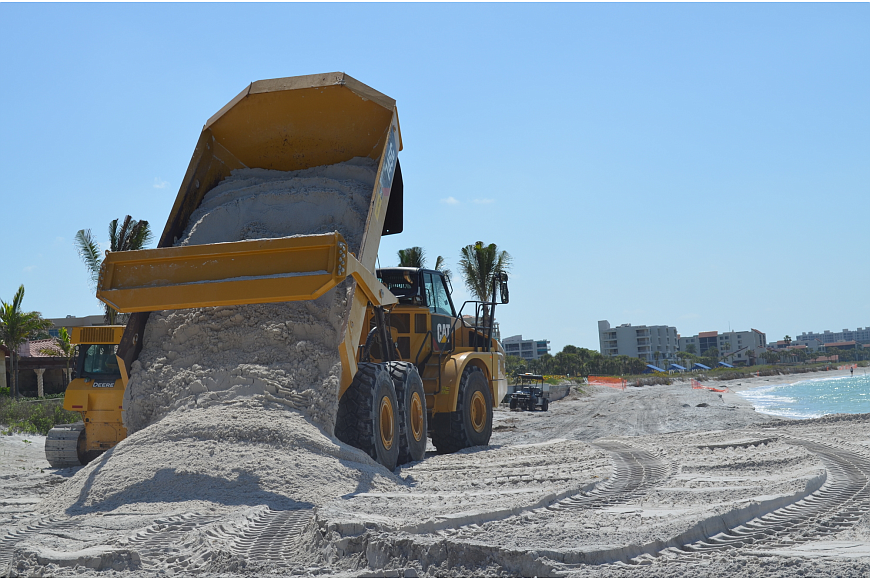- May 4, 2024
-
-
Loading

Loading

Siesta Key residents continue to search for a way around the city’s plans to dredge Big Pass for a long-term Lido Beach renourishment project with the U.S. Army Corps of Engineers.
That’s why, on May 5, Longboat Key Town Manager Dave Bullock found himself on a different barrier island, explaining the town’s ongoing truck haul beach project to the Siesta Key Association.
Although Siesta residents might want the city to follow Longboat’s example to avoid disturbing the coastal status quo, Bullock made clear that the truck project was not his first choice to replenish the eroding shoreline.
“You think, ‘Why would anyone want to haul sand by truck?’” Bullock said. “‘It must be inconvenient and expensive.’ And it is.”
Bullock said the cost for the truck haul project can be two or three times more expensive than dredging an inlet or finding an offshore sand source, two more traditional renourishment options.
That’s not to say the truck haul is without its advantages. Longboat was unable to locate an offshore sand source that matched the quality of the sand on its beaches, and the Immokalee mine serving as the source for the truck haul has a nearly unlimited supply of compatible sand. More than a month into the renourishment, Bullock said the town has only received two complaints about the trucks.
“I was pretty nervous,” Bullock said. “It’s worked surprisingly well in terms of impact on the community.”
City Engineer Alex DavisShaw said the city would consider truck haul projects for renourishment emergencies. Still, she said scrapping the Big Pass renourishment — which, at 1.3 million cubic yards, is more than six times larger than Longboat’s project — isn’t economically feasible.
“For the Army Corps project, it would be cost-prohibitive to get all the sand we need that way,” DavisShaw said.
DavisShaw said the Army Corps is currently reviewing its plans for Lido with the agencies that are required to evaluate the dredging project, including the Florida Department of Environmental Protection. The federal organization will likely resubmit its proposal within the next month or two, DavisShaw said.
There are Florida governments embarking on truck haul projects larger than Longboat’s. In Broward County, 38,000 trucks brought in 750,000 cubic yards of sand to renourish three beaches earlier this year.
However, that work comes at a significant price. The Broward project had a price tag of $55 million, nearly twice the cost estimates for the Army Corps project on Lido.
Bullock also shared some insight on another element of the Army Corps proposal that’s caused concern among Siesta residents. The Lido project calls for the installation of two sand-retaining groins along the shoreline, designed to prevent sediment from traveling to the south as quickly.
Siesta stakeholders have questioned the impact those groins would have on the natural flow of sand. Will Siesta Beach, located to the south of Lido, lose out on the sand it has typically received from the north? Army Corps and city officials say the sand will travel regardless of whether the groins are there, but an unease still exists among Siesta residents.
For his part, Bullock offered a glowing review of the groins on Longboat Key. Although Longboat’s groins differ from those proposed on Lido — Longboat has adjustable concrete piers, while Lido’s would use rocks — Bullock said the impact has been noticeable on the town’s beaches.
“It works in both areas we have them,” Bullock said. “We could not hold sand in either of those areas until we put those structures in.”
Bullock pointed out the Longboat shoreline continues to the south of the areas where the groins were installed — and the town isn’t interested in preserving one portion of its shore to the detriment of another. Throughout the meeting, he attempted to avoid the specifics of the Siesta-Lido showdown over Big Pass, instead providing anecdotes from his experience on Longboat Key.
Still, toward the end of his presentation, he acknowledged the dynamic ecosystem on the region’s shores — which is clearly a guiding principle as Siesta Key residents signal their opposition to the city’s plans for Big Pass.
“Nothing on the beach works without consequence,” Bullock said. “There’s always a consequence.”